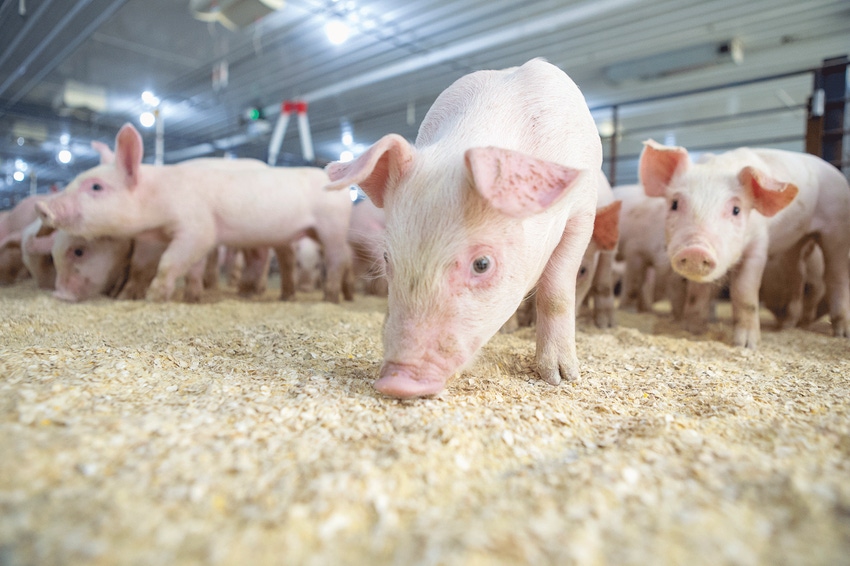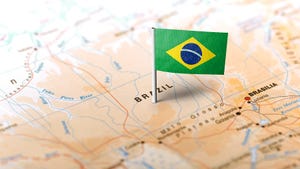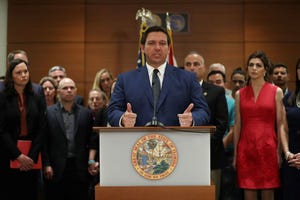20 years of DDGS lessons in pig diets
This is the first installment of a series answering the question “What have we learned about feeding DDGS to pigs over the past 20 years?”
November 1, 2018

By Jerry Shurson, University of Minnesota Department of Animal Science
Much has changed in the choices of feed ingredients available and the way we formulate swine diets over the last 20 years. One of the most significant changes is the use of corn dried distillers grain with solubles in diets in all phases of pork production.
In 1998, when the U.S. ethanol industry was in its infancy, about 1.3 million metric tons of DDGS was produced, with only about 52,000 tons (4%) fed to swine. Today, more than 37 mmt of DDGS are being produced, of which more than 5 mmt (14%) are being fed to swine domestically, and another 13 mmt (35%) are being exported for use primarily in swine and poultry diets in Asia and Latin America.
Related: Varied energy and digestible amino acids levels in DDGS manageable
This dramatic increase in DDGS use in swine diets has occurred for three reasons: abundant supply in major U.S. pork production states, high nutritional and economic value relative to corn and soybean meal, and extensive research demonstrating that DDGS can be successfully used at high diet inclusion rates (up to 30%) in all phases of production to achieve optimal performance.
Related: Varied energy and digestible amino acids levels in DDGS manageable
DDGS, corn energy similar
On average, corn DDGS contains similar metabolizable energy (ME: 3,396 kilocalories per kilogram) and net energy (NE: 2,343 kilocalories per kilogram) content, compared with corn (ME: 3,395 kilocalories per kilogram, NE: 2,672 kilocalories per kilogram) for swine. As a result, the DDGS price is generally highly correlated with the corn price in the feed ingredient market. However, the energy content varies considerably among sources, with ME content ranging from 2,959 kilocalories per kilogram (Dahlen et al., 2011) to 4,336 kilocalories per kilogram (Pedersen et al., 2007); and NE content ranging from 2,012 kilocalories per kilogram (Kerr et al., 2015) to 2,915 kilocalories per kilogram (Wu et al., 2016a) on a dry matter basis.
Related: Work continues to evaluate performance responses from feeding DDGS
One of the reasons for the high variability in energy content among DDGS sources is that the majority (over 90%) of ethanol plants are extracting some of the corn oil prior to manufacturing DDGS. However, we have learned from research studies that oil (crude fat) content of DDGS is a poor single predictor of ME and NE value for swine (Anderson et al., 2012; Kerr et al., 2013).
Therefore, to manage this variability and provide accurate ME and NE estimates of the DDGS source(s) being used, ME prediction equations based on chemical composition measures have been developed and validated (Urriola et al., 2014; Wu et al., 2016b) for use in swine diets. In fact, some commercial companies use similar prediction equations to provide services to nutritionists and pork producers for comparing relative economic value, and customized energy and nutrient loading values for feed formulation of various DDGS sources.
Related: Work continues to evaluate performance responses from feeding DDGS
These approaches minimize the risk of overestimating and underestimating energy and digestible amino acid and phosphorus content in DDGS as part of precision swine feeding programs.
Installments in the DDGS series
Part 1: 20 years of DDGS lessons in pig diets
Part 2: Varied energy and digestible amino acids levels in DDGS manageable
Part 3: Work continues to evaluate performance responses from feeding DDGS
Part 4: Managing carcass yield, pork fat quality when feeding corn DDGS
Part 5: Reaching an understanding of fiber characteristics of corn DDGS
Part 6: Enzymes, pre-treatment improve fiber and nutrient digestibility
Part 7: DDGS show greater antioxidant capacity than in corn grain

Soybean meal comparison
Although the protein content of DDGS (27%) is more than three times greater than corn (8%), it is much less than that found in dehulled, solvent-extracted soybean meal (47%). This is one of the reasons that DDGS price is less influenced by soybean meal price than by corn price.
More importantly, the lysine content relative to crude protein content in DDGS (2.97%) is about half of the lysine:crude protein in soybean meal (6.20%).
Although the concentrations, balance and digestibility of amino acids in DDGS are inferior to that of soybean meal, it does partially replace soybean meal in swine diets when adequate amounts of crystalline lysine, threonine and tryptophan are supplemented. Unfortunately, crude protein content is a poor predictor of indispensable amino acid content in DDGS (Olukosi and Adebiyi, 2013), and color (Minolta or Hunter L* and b*) is a poor predictor of amino acid digestibility among DDGS sources (Urriola et al., 2013).
However, like energy, the amino acid content and digestibility varies substantially among DDGS sources (Olukosi and Adebiyi, 2013; Zeng et al., 2017), with standardized ileal digestibility (SID) of lysine (CV = 13.5%), tryptophan (CV = 12.5%), isoleucine (CV = 9.2%) and threonine (CV = 7.1%) being the most variable (Zeng et al., 2017). Fortunately, prediction equations have been developed to accurately estimate the SID amino acid content of DDGS sources for swine (Zeng et al., 2017), which further support precision nutrition swine feeding programs when using DDGS.
Phosphorus content of DDGS
Another unique and economically valuable nutritional component of DDGS is its relatively high amount of standardized total tract-digestible (STTD) phosphorus content (0.47%) compared with corn (0.09%), soybean meal (0.34%) and other grain and grain byproduct sources (NRC, 2012). Phosphorus is the third-most expensive nutritional component in swine diets, following energy and amino acids.
As corn is fermented to produce ethanol and DDGS, the phosphorus content is not only concentrated, but much of it is also converted to a more digestible form. As a result, substantial amounts of expensive inorganic phosphate supplements can be partially replaced in swine diets when DDGS is added — which not only reduces diet cost, but also reduces the amount of indigestible phosphorus being excreted in manure.
However, the STTD phosphorus content also varies among DDGS sources, with digestibility coefficients ranging from 59% (Hanson et al., 2011) to 77% (Rojas et al., 2013). The addition of phytase has minimal effects on improving phosphorus digestibility in DDGS for swine (Almeida and Stein, 2012; Rojas et al., 2013), and crude fat content of DDGS has no effect on STTD of phosphorus among DDGS sources (She et al., 2015). Prediction equations have been developed (Almeida and Stein, 2012) to estimate the STTD of phosphorus in DDGS for swine; but unfortunately, they are not sufficiently accurate (R2 = 0.20) for commercial application.
Therefore, the conservative estimate (NRC, 2012) of 65% STTD of phosphorus in DDGS should be applied to the total phosphorus content of the DDGS sources being used when formulating swine diets.

DDGS’ economic value
Due to the high ME and NE and digestible phosphorus content, and relatively high digestible amino acid content of DDGS compared with corn and soybean meal, the economic value of using DDGS in swine diets can be as much as $60 to $100 per ton greater than the purchase price.
Numerous studies have shown that adding high amounts of DDGS (up to 30% in phases 2 and 3 of nursery, growing-finishing diets and lactation diets, and up to 50% in gestation) to diets maintains performance comparable to feeding conventional corn-soybean meal diets (Stein and Shurson, 2009).
Significant feed cost reductions have been achieved by using these high DDGS inclusion rates — to the point where many large pork producers are attempting to find ways to use even greater amounts (50% to 60%) in grower-finisher diets.
Check threonine requirements
However, to achieve optimal growth performance and carcass composition when feeding diets containing more than 30% DDGS, re-examining the threonine requirements and managing excess leucine relative to isoleucine and valine must be considered.
The high fiber content of DDGS may increase the threonine requirement because of increased mucin production in the gastrointestinal tract, which occurs when feeding high-fiber diets to pigs. Mucin contains significant amounts of threonine, which is lost and not used for growth. Corn protein in DDGS also contains high amounts of leucine relative to the pig’s requirement, and excess leucine reduces the use of two other branch-chain amino acids — valine and isoleucine.
Take care using DDGS
Therefore, feeding diets containing high amounts of DDGS may result in suboptimal growth performance if these conditions are not properly managed in diet formulation.
Research is underway to evaluate ways to overcome these challenges and further increase DDGS use in nursery and growing-finishing pig diets.
References
Almeida, F.N., and H.H. Stein. 2012. Effects of graded levels of microbial phytase on the standardized total tract digestibility of phosphorus in corn and corn coproducts fed to pigs. J. Anim. Sci. 90:1262-1269.
Anderson, P.V., B.J. Kerr, T.E. Weber, C.J. Ziemer, and G.C. Shurson. 2012. Determination and prediction of digestible and metabolizable energy from chemical analysis of corn coproducts fed to finishing pigs. J. Anim. Sci. 90:1242-1254.
Dahlen, R.B.A., S.K. Baidoo, G.C. Shurson, J.E. Anderson, C.R. Dahlen, and L.J. Johnston. 2011. Assessment of energy content of low-solubles corn distillers dried grains and effects on growth performance, carcass characteristics, and pork fat quality in growing- finishing pigs. J. Anim. Sci. 89:3140–3152.
Hanson, A.R., G. Xu, M. Li, M.H. Whitney, and G.C. Shurson. 2011. Impact of dried distillers grains with solubles (DDGS) and diet formulation method on dry matter, calcium, and phosphorus retention and excretion in nursery pigs. Anim. Feed Sci. Technol. 172:187-193.
Kerr, B.J., N.K. Gabler, and G.C. Shurson. 2015. Formulating diets containing corn distillers dried grains with solubles on a net energy basis: Effects on pig performance and energy and nutrient digestibility. Prof. Anim. Scientist 31:497-503.
Kerr, B.J., W.A. Dozier, III, and G.C. Shurson. 2013. Effects of reduced-oil corn distillers dried grains with solubles composition on digestible and metabolizable energy value and prediction in growing pigs. J. Anim. Sci. 91:3231-3243.
NRC. 2012. Nutrient requirements of swine. 11th rev. ed. Natl. Acad. Press, Washington, D.C.
Olukosi, O.A., and A.O. Adebiyi. 2013. Chemical composition and prediction of amino acid content of maize- and wheat-Distillers’ Dried Grains with Soluble. Anim. Feed Sci. Technol. 185:182-189.
Pedersen, C., M. G. Boersma, and H. H. Stein. 2007. Digestibility of energy and phosphorus in ten samples of distillers dried grains with solubles fed to growing pigs. J. Anim. Sci. 85:1168–1176.
Rojas, O.J., Y. Liu, and H.H. Stein. 2013. Phosphorus digestibility and concentration of digestible and metabolizable energy in corn, corn coproducts, and bakery meal fed to growing pigs. J. Anim. Sci. 91:5326-5335.
She, U., Y. Su, L. Liu, C. Huang, J. Li, P. Li, D. Li, and X. Piao. 2015. Effects of microbial phytase on coefficient of standardized total tract digestibility of phosphorus in growing pigs fed corn and corn co-products, wheat and wheat co-products and oilseed meals. Anim. Feed Sci. Technol. 208:132-144.
Stein, H. H., and G. C. Shurson. 2009. The use and application of distillers dried grains with solubles in swine diets. J. Anim. Sci. 87:1292–1303.
Urriola, P. E., M. Li, B. J. Kerr, and G. C. Shurson. 2014. Evaluation of prediction equations to estimate gross, digestible, and metabolizable energy content of maize dried distillers grains with solubles (DDGS) for swine based on variable chemical composition. Anim. Feed Sci. Technol. 198:196-202.
Urriola, P. E., L. J. Johnston, H. H. Stein, and G. C. Shurson. 2013. Prediction of the concentration of standardized ileal digestible amino acids in distillers dried grains with solubles. J. Anim. Sci. 91:4389–4396.
Wu, F., L.J. Johnston, P.E. Urriola, A.M. Hilbrands, and G.C. Shurson. 2016a. Evaluation of NE predictions and the impact of feeding maize distillers dried grains with solubles (DDGS) with variable NE content on growth performance and carcass characteristics of growing-finishing pigs. Anim. Feed Sci. Technol. 215:105-116.
Wu, F., L.J. Johnston, P.E. Urriola, A.M. Hilbrands, and G.C. Shurson. 2016b. Evaluation of ME predictions and the impact of feeding maize distillers dried grains with solubles with variable oil content on growth performance, carcass composition, and pork fat quality of growing-finishing pigs. Anim. Feed Sci. Technol. 213:128-141.
Zeng, Z.K., G.C. Shurson, and P.E. Urriola. 2017. Prediction of the concentration of standardized ileal digestible amino acids and safety margins among sources of distillers dried grains with solubles for growing pigs: A meta-analysis approach. Anim. Feed Sci. and Technol. 231:150-159.
You May Also Like



